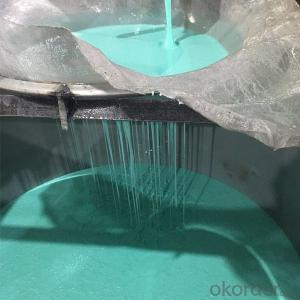Silicone rubber for gypsum molds making
- Loading Port:
- Shekou
- Payment Terms:
- TT OR LC
- Min Order Qty:
- 100 kg
- Supply Capability:
- 200000 kg/month
OKorder Service Pledge
OKorder Financial Service
You Might Also Like
Specification
1. Description
YJS-520 is with hardness Shore A 20. It is a kind of of two- component materials consisting of a flowable part A which when mixed with the curing agent or catalyst,cures at room temperature by a condensation reaction. It is widely used for making molds for candle, soap, wax, plaster cornice, small crafts, cement/concrete decorative products etc.
2. Features
-Amazing fluidity and easy to operate
-Complex design available
-Not Oily
-Stable quality, non-toxic and odorless catalyst provided
-Easy de-molding
-Excellent tension and tear strength
-High performance in duplication
-Shrinkage is almost zero (below 0.2)
-Excellent resistance to weather, temperature, aging, acid and aging-proofing.
3.Technical datasheet
Typical general characteristics | Inspection Method | Value |
Product data (Catalyzed A+B) | YJS-520 | |
Hardness | Shore A | 20±2 |
Mix Ratio | A:B | 100:2 |
Color | / | White |
Pot life | 25 ℃ (77F) | 30-40mins |
Curing time | 25 ℃ (77F) | 3-4 hours |
Mixed viscosity | mPa.s | 18000±2000 |
Tear-strength | kg/cm | 20±2 |
Tensile-strength | M.pa | ≥3.1 |
Elongation | % | ≥480% |
Shrinkage | % | ≤0.2% |
4. Using instructions
Step 1: Prepare and clean the prototype.
You must make sure your original molds perfect. fix the original mold on a board , then using some assistant material(like cardpaper) to make a frame for to surround the prototype. The frame is no need ,if we make the mold by brushing way .
Step 2: Take the silicone and catalyst as the ratio 100:2 (silicone:catalyst=100:2) ,mix the silicone rubber and catalyst evenly.
*Notes: Molding silicon rubber is a kind of flowing liquid and it contains two parts. Part A is a kind of flowing liquid and part B is the curing agent. Remember to mix part A and part B evenly, otherwise the silicon rubber will be partly solidified and this will bring troubles for your final operation. What’s more, the finished molds will have a short life. All of these will cause a waste of silicon rubber.
Step 3: Vacuum pumping
After mixed the silicone evenly, it is better to release the bubble by Vacuum pumping.
Step 4: Pouring cast or brushing cast
After released the bubble, we can pour/brush the silicone rubber on the prototype
*Notes:Please finished all the steped within the operation time .If not it will cause cross linking reaction, and no more further steps will be available.So,we have to pay attention to the pot life and curing time.
5.Appearance
Part A: Silicone rubber is a white liquid
Part B: Catalyst is a non-toxic and odorless liquid, white transparent color.
ATT: We can provide fast/medium/slow catalyst of for hot, warm or cold season.
6.SHELF LIFE:
When stored at or below 32°C (89.6°F) in the original unopened containers, YJS-5 series Silicone Base and its Curing Agents have a usable life of 10 months.
7.Package
Silicone base:1kg/drum; 20kg/drum;25kg/drum;200kg/drum.
Curing Agent: 30g/bottle; 1kg/bottle
- Q: Is the resin a dangerous chemical? Is there any other alias?
- Do not know what kind of resin you said.
- Q: Storage of organic chemicals in the warehouse, ventilation requirements
- The use of anti-static ventilation fan ventilation.
- Q: Hazardous Chemicals Inorganic Classes, Organic Classes What does it mean?
- Hazardous chemicals refer to highly toxic chemicals and other chemicals that are harmful to humans, facilities and the environment, which are toxic, corrosive, explosive, burning and burning. Including explosives, compressed and liquefied gases, flammable liquids, flammable solids, spontaneous combustion and wet flammable materials, oxidants and organic peroxides, toxic and corrosive substances, etc.
- Q: Calcium fatty acid is an organic or inorganic chemical
- All fatty acids are organic chemicals
- Q: How to distinguish between inorganic chemicals and organic chemicals
- There is no absolute boundary between the organic compound and the inorganic compound. Organic chemistry has become an independent discipline in chemistry because organic compounds do have their inherent relationships and characteristics.
Send your message to us
Silicone rubber for gypsum molds making
- Loading Port:
- Shekou
- Payment Terms:
- TT OR LC
- Min Order Qty:
- 100 kg
- Supply Capability:
- 200000 kg/month
OKorder Service Pledge
OKorder Financial Service
Similar products
Hot Searches
Related keywords

























